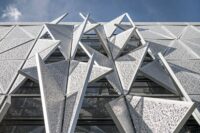- Home
- Articles
- Architectural Portfolio
- Architectral Presentation
- Inspirational Stories
- Architecture News
- Visualization
- BIM Industry
- Facade Design
- Parametric Design
- Career
- Landscape Architecture
- Construction
- Artificial Intelligence
- Sketching
- Design Softwares
- Diagrams
- Writing
- Architectural Tips
- Sustainability
- Courses
- Concept
- Technology
- History & Heritage
- Future of Architecture
- Guides & How-To
- Art & Culture
- Projects
- Interior Design
- Competitions
- Jobs
- Store
- Tools
- More
- Home
- Articles
- Architectural Portfolio
- Architectral Presentation
- Inspirational Stories
- Architecture News
- Visualization
- BIM Industry
- Facade Design
- Parametric Design
- Career
- Landscape Architecture
- Construction
- Artificial Intelligence
- Sketching
- Design Softwares
- Diagrams
- Writing
- Architectural Tips
- Sustainability
- Courses
- Concept
- Technology
- History & Heritage
- Future of Architecture
- Guides & How-To
- Art & Culture
- Projects
- Interior Design
- Competitions
- Jobs
- Store
- Tools
- More
Unlocking AI Rendering for Advanced Architectural Visualization

In the dynamic digital landscape of today, AI rendering is rapidly emerging as a game-changer in architecture. If you’re eager to delve into how it’s revolutionizing architectural design, you’re in the right spot. We’re set to explore the transformative potential and advantages of AI tools for rendering.
Artificial Intelligence Rendering, a cutting-edge technology, harnesses machine learning algorithms to expedite the creation of photorealistic images and animations. Unlike traditional rendering that relies heavily on computational power, AI utilizes neural networks for faster and more precise calculations. This innovation is not only enhancing architectural visualization, but also redefining standards for speed, realism, and efficiency in computer graphics.
While AI may have replaced the architect’s hand with algorithms and machine learning processes, the essence of architectural rendering’s original artistry remains intact. Join us as we venture into the world of AI rendering in architecture and how to leverage it.

Table of Contents
ToggleUnderstanding AI Rendering in Architecture
Building on the introduction to AI rendering, we delve deeper, dissecting the concept and workings of AI rendering in architecture.
What is AI Rendering?
AI Rendering, a pivotal force in architectural design, harnesses machine learning algorithms. Unlike conventional methods backed by extensive computational power, AI Rendering capitalizes on neural networks. This strategy propels more swift and precise calculations, transforming light interactions with 3D models into photorealistic images and animations. A classic example finds application in architectural visualization, video game workflows, and automotive designs.
How AI Rendering Software Works
Performance of AI Rendering Software orchestrates upon two fundamental pillars – the Central Processing Unit (CPU) and Graphics Processing Unit (GPU). Primarily, these units provide the colossal computing power needed during the rendering process. Time consumption hinged on hardware limitations gets mitigated through the advent of Artificial Intelligence and Machine Learning. AI expedites the process, devising solutions faster than complex algorithms relied upon earlier. Resultantly, AI makes rendering swifter, streamlined and more simplified – all advancing towards an enhanced state of architectural design.

Identifying the Best AI Rendering Tools
AI rendering revolutionizes architectural design. Equipped with the right tools, you achieve photorealistic images faster and more accurately. This section explains what to focus on during tool selection and outlines some leading AI Rendering tools in the market.
Key Features to Look For
- Speed and Efficiency: An efficient tool executes tasks swiftly, taking less time to render an image. AI enabling it processes information faster, hence an indispensable feature.
- Quality of Images: Maintain a keen eye for tools that produce high-grade, lifelike images. High-quality output bolsters the effectiveness of architectural visualizations.
- Simplicity and User-friendliness: A tool that presents a steep learning curve downgrades the user experience. Embrace tools that offer straightforward interfaces and streamlined workflows.
- Versatility: Versatile tools defy limitations. They successfully accommodate a wide array of architectural styles and designs, proving indispensable to architects.
- AI and Machine Learning Integration: Tools integrating AI and Machine Learning stand out. They foster efficiency by learning and adapting to users’ preferences.
- RoomSketcher: Emerging in 2007, RoomSketcher gives users a simple tool for high-quality architectural rendering. It specializes in floor plan creation, interior decoration, and 3D visualization. Real estate professionals and homeowners alike use RoomSketcher to bring their visualizations to life.
- ARCHITEChTURES: ARCHITEChTURES uses AI to empower architects, liberating them from mundane tasks. It excels in navigating constraints, exploring opportunities, and facilitating accurate and easy adjustments. Through automation, it sets design parameters to work with, presenting endless possibilities.
- ARK: ARK bears an AI brain that scrutinizes and learns architectural design metadata. It spawns variations accommodating local US regulations and ordinances, making it a potent AI rendering tool.
- Samsung’s AI Software: Samsung’s AI software promises impactful results in rendering. It generates renders resembling real-life photos, demonstrating the potential of using AI in architectural design.
Choosing an AI Rendering Tool ultimately depends on individual preferences, specific use cases, and work requirements, anchored by the key features explained above. The tools overviewed usher users into the world of AI Rendering, aiding most effectively in the journey towards excellent architectural visualization.

Getting Started with AI Rendering
Embracing AI rendering facilitates an exponential enhancement in architectural visualization. Let’s step into the practical sphere and explore the setup and creation of your first AI Rendering.
Setting Up Your AI Rendering Software
In the burgeoning arena of AI Rendering tools, RoomSketcher is a stand-alone platform that gifts users the ability to conjure 3D home visuals efficiently. The setup process begins by accessing the dedicated website and following the registration process. Upon account creation, users gain access to a personalized dashboard.
The dashboard houses myriad design tools that serve the user by simplifying floor plan creation, interior decoration, and, critically, enabling 3D visualization. Initial setup requires configuration of design parameters in line with user needs, such as room sizes, window placements, and other building details. With these inputs stored, the software generates visuals based on the user-specified variables, tapping into its AI components to produce architectural models in minutes rather than hours. During this setup phase, one takes advantage of the built-in tools offering smart object placement, rule-violation feedback, material selection advice, and cost estimation tools.
Examples of these setup parameters include detailed site constraints and relevant by-laws guiding construction. The tool’s AI capabilities kick in, navigating these constraints and converting your inputs into a visible, interactable, and, above all, editable 3D model.
Creating Your First AI Rendering
The creation of your first AI Rendering pivots on the tools afforded by the AI rendering software. For example, ARCHITEChTURES equips designers with necessary, advanced tools for generating AI-powered visuals, accelerating the production of scalable designs.
Start by uploading the architectural design – the software digests this input and, using its grand library of design criteria, outlines and alerts any rule violations. Subsequently, adjust and refine the architectural design as necessary, ensuring the output model aligns better with existing regulations and codes.
As the design conforms to the necessary standards, engage with the software’s AI capabilities. Indicate a text or keyword input that influences the texture, color, and other design aspects in the visual output. Once rendered, the model explores not only the building but also its positioning within the surrounding environment.
Consider the illustrative case of RoomSketcher, which initiates the rendering process with the creation of 2D floor plans. Following the floor plan generation, users select design elements like furniture, fixtures, colors, and materials for the interior space. Post-selection, one activates the 3D Photo function, and the AI algorithms get to work, recreating the selected plan in three-dimensional, visually accessible detail.
By continually experimenting and engaging with these AI rendering tools, one learns to harness the power of the software, optimize architectural visualization, and produce better, more efficient, and more aesthetically pleasing building designs.

Optimizing Your Renderings: Practical Tips
In delivering top-tier presentations and immersive experiences, optimization of renderings paves the way to achieving such results. This section provides significant knowledge about amplifying the potential of your architectural visuals via AI rendering software.
Scene Optimization Techniques
Scene optimization involves strategic modifications to improve your scene’s rendering efficiency. Prune redundant objects from your scene that will not significantly alter the final output. For example, objects otherwise not visible or making a negligible impact on your rendering deserve removal. Simplify your architectural models where possible, reducing unnecessary vertices and faces that may bloat your computation times. For instance, you might opt to remove details from a model like intricate moldings on a distant building that your audience won’t notice. Always render at the appropriate size and resolution, basing it on the final output medium rather than arbitrarily high values. For example, a rendering meant for a website display doesn’t need the same resolution as a billboard print.
Efficient Material Editing
Material editing is an essential part of rendering, substantially impacting the final image’s quality. Leverage pre-made materials from the AI rendering programs’ libraries, such as RoomSketcher and ARCHITEChTURES. Pre-made materials, like wooden floors or concrete walls, can save extensive time and offer photorealistic results. Reuse the materials across multiple assets in your scene where suitable, reducing inconsistencies, making your scene cohere, and enhancing the speed of rendering. For instance, you may apply the same glass material to all windows within a building. Use bump and displacement maps sparingly, as they can significantly extend computation time. Only implement them for close-up shots where the added detail is noticeable and can enhance the final image. For example, a brick wall texture seen from a far isn’t likely to benefit from a bump map.
Automated vs Manual Editing
Deciding between automated or manual editing hinges on your project’s specifics and available resources. Automated editing, powered by AI, boasts significant time and effort savings. ARCHITEChTURES exemplifies this benefit with its smart object placement and instant feedback on rule violations. Conversely, manual editing grants a higher level of control and precision over the final outcome. ARK, with its AI brain that scrutinizes and learns the metadata of architectural designs, offers a compromise, blending efficient automated processes with the flexibility of making manual adjustments. This combination accords architects the liberty to iterate concepts rapidly and attain an optimal balance between speed, quality, and cost-effectiveness.

Advanced AI Rendering Tactics
After detailing a few initial strategies on how to best use AI for rendering, let’s dig deeper and uncover some advanced tactics. These methods can boost your efficiency, enhance your designs, and maximize the potential of architectural visualization.
Using AI for Large Scale Structures
Turning to extensive, large scale architectural projects often brings about an immense complexity. Be it a stadium, a multi-story car park, or an entire city block, rendering these structures requires monumental computational power.
Enter AI rendering, a reliable robust companion in executing such complex tasks. Take ”Maketai” and ”ARCHITEChTURES” as two examples. By utilizing machine learning algorithms, these software can churn through massive datasets, producing high-quality renders in a fraction of the time traditionally required. They analyze site conditions, climate dynamics, budget constraints, and client aspirations, thereby unveiling an array of design options.
Parametric Architecture with AI Rendering
Parametric design is deeply rooted in exploiting mathematical rules and constraints to shape buildings. While exciting, this method can be challenging to visualize and render.
Through AI tools like DALLE 2 developed by OpenAI, the hurdles of parametric design recede. The software permits architects to generate visuals rapidly with simple text or keyword input. This feature promotes quick ideation and the rendering of concepts, magnifying the efficiency.

AI Renderings for Smart City Designs
Decoding and rendering the multiple layers of a smart city presents a colossal challenge. However, AI integration simplifies the process substantially. From domestic buildings like RoomSketcher to design plans like ARCHITEChTURES, AI rendering enables visualization and simulations that respect environmental constraints, user requirements, and the interdependencies that smart cities thrive upon.
With these AI-driven tactics in your toolbelt, engagement with ambitious and complex architectural projects becomes a delightful journey rather than a daunting task. The influence of artificial intelligence on rendering in architecture proves unbounded; place trust in its capabilities, and you’ll experience a notable transformation in your design and presentation abilities.
Addressing Common Concerns
Addressing concerns is pivotal in broadening the understanding and acceptance of AI in rendering architecture. This subsection aims to clarify some common misleading assumptions about AI’s role in architecture rendering.
Will AI Replace 3D Artists?
The fear of AI replacing 3D artists in architecture is widely circulated. However, it’s crucial to clarify that, instead of replacement, AI assists 3D artists in enhancing and expediting their work. Utilizing AI tools like ARCHITEChTURES and DALLE 2, artists can automate routine and mundane tasks, freeing up their time for strategic, creative inputs. This collaboration between AI and 3D artists lies in optimizing visualizations and speeding up the design process while keeping the artistic discretion in the hands of the professionals.
To exemplify, ARCHITEChTURES assists with accurate building and site planning by navigating constraints and exploring opportunities. Through automated 3D visualization, artists can focus on crucial elements of a design and make informed choices without being bogged down by routine tasks. Similarly, DALLE 2, developed by OpenAI, enables artists to rapidly generate visuals using simple text or keyword input, thereby fostering swift ideation and concept rendering.
Rather than replacing the artist, AI plays a supportive role in enhancing the skills and capabilities of 3D artists in producing superior quality architectural renderings.
Submit your architectural projects
Follow these steps for submission your project. Submission FormLatest Posts
Veo 3 for Architecture: Free Prompts & How to Master Visual Design Videos
Veo 3 introduces AI-powered video generation for architecture, allowing designers to present...
Midjourney Video Update: A New Era for AI Architecture & Landscape Design
Midjourney’s new video feature introduces AI-powered animation for architectural and landscape renders,...
Google Nano Banana and Architecture: What This New Image Generator Means for Designers
Nano Banana is a new benchmark for testing how well AI models...
The Ethics of AI in Architecture
Ethics of AI in architecture, clarified: bias audits, human-in-the-loop guardrails, IP and...












Leave a comment